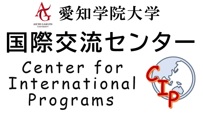マレーシアの提携校によるウェビナー「日本とマレーシアの中元節及びお盆の祭りの比較」9/17開催のご案内
マレーシアの提携校 トゥンク・アブドゥル・ラーマン大学(UTAR)が主催して行うウェビナーの案内がありました。
テーマは「Variation of Zhongyuan Festival and Obon Festival: Comparison of Customs in Malaysia and Japan」です。
ウェビナーは中国語と日本語通訳により行われます。詳細は以下の通りです。
参加をご希望の方は、Eメールにより以下情報を国際交流センターへご連絡ください。Eメールによりウェブナーの詳細と申込方法をお送りさせていただきます。
Eメールアドレス: aguiec@dpc.agu.ac.jp
Eメール内容:①ご所属 ②お名前 ③Eメールアドレス ④UTAR主催ウェビナーへの参加を希望します
以下、実施校からの開催案内の原文です。
-----------------------------------------------------------------------------
中元节及盂兰盆节的时空变异:马来西亚和日本的习俗比较
Variation of Zhongyuan Festival and Obon Festival: Comparison of Customs in Malaysia and Japan
联合举办:马来西亚拉曼大学 & 日本小松大学
Jointly Organised by Universiti Tunku Abdul Rahman (UTAR), Malaysia & Komatsu University (KU), Japan
日期:2020年9月17日
Date:17th September 2020
时间 :2:00-3:30pm (Malaysia)/ 3:00-4:30pm (Japan)
Time:2:00-3:30pm (Malaysia)/ 3:00-4:30pm (Japan)
时长:一个半小时 (包括分享和问答环节)
Duration: one and half hour (including talk and Q&A)
主讲人:杜忠全 博士(UTAR中华研究院中文系主任)& 西村 聡 教授(小松大学国际文化交流学部)
Speaker: Assistant Prof. Dr Toh Teong Chuan (UTAR Head of Deparment, Institute of Chinese) &
Prof. Satoshi Nishimura (KU Faculty of Intercultural Communication Department of Intercultural Communication)
司仪:陈爱梅 博士 (UTAR中华研究院研究部课程主任)
Emcee: Assistant Prof. Dr. Tan Ai Boay (UTAR Head of Programme (Postgraduate Degree Programmes))
主持人:岩田 礼 教授 (小松大学国际文化交流学部 学部長)
Moderator:Prof. Ray Iwata (Dean, KU Faculty of Intercultural Communication Department of Intercultural Communication)
平台:ZOOM
Platform: Zoom
中元是东南亚华人的文化遗产,不论走在中国,香港,澳门,台湾,新加坡,泰国或马来西亚,都会看到“鬼火”(焚香),听到鬼故事。鉴于僧道俗三结合的特性,中元习俗也随之多元化。它既是民间鬼节,又是道家的中元和佛教的盂兰盆节。盂兰盆节在飞鸟时代由隋唐时期的中国传入日本,俗称「御盆」(日语:お盆/おぼん Obon ),為盂兰盆会的简称。在城市七月十三日至十六日,在农村八月十三日至十六日进行。十三日前扫墓,十三日接先人鬼魂,十六日送。也有送中元礼物的习惯,民俗上也会众人聚集,跳一种名曰「盆踊」的舞蹈。日本人对盂兰盆节很重视,现已成为仅次于元旦的重要节日,企业、公司一般都会放假一周左右,称为“盆休”,很多出门在外工作的日本人都在选择利用这个假期返乡团聚祭祖,此时像大都市(如東京、大阪等)街道多显冷清,有点类似華人的清明节。
Zhongyuan is the cultural heritage of Chinese in Southeast Asia. Whether you walk in China, Hong Kong, Macau, Taiwan, Singapore, Thailand or Malaysia, you will see "ghost fire" (incense) and hear ghost stories. In view of the characteristics of the three-combination of monk, Taoism and customs, the customs of Zhongyuan also diversified. It is not only the festival of ghosts, but also the Yulan festival of Taoism and Buddhism.The Yulan Festival was introduced to Japan from China in the Sui and Tang Dynasties during the Asuka era. It is commonly known as "Open" (Japanese: Obon), short for Obon. It takes place from July 13th to 16th in the city and from August 13th to 16th in the countryside. Sweep the tomb on the 13th, pick up the ghosts of the ancestor on the 13th, and send it on the 16th. There is also the habit of giving gifts, in folk customs, people gather to dance a dance called "Pen Po".The Japanese attach great importance to the Obon Festival and it has become an important holiday second only to New Year's Day. Companies and companies generally have a holiday for about a week, which is called the "pen holiday". Many Japanese who go out to work are choosing to use this holiday. Returning home to reunite to worship the ancestors. At this time, the streets of big cities (such as Tokyo, Osaka, etc.) are often deserted, a bit similar to the Chinese Ching Ming Festival.
演讲内容 Talk contents:
杜忠全博士 Assistant Prof. Dr Toh Teong Chuan
· 中元节由来 The origin of Zhongyuan Festival
· 道家的中元和佛教的盂兰盆节 The Zhongyuan of Taoism and the Yulan Festival of Buddhism
· 马来西亚中元庆典和习俗 Malaysia’s Zhongyuan (Ghost Festival) celebration and custom (by Assistant Prof. Dr Toh Teong Chuan)
西村聡教授 Prof. Satoshi Nishimura
· 日本盂兰盆节 Japan’s Obon Festival
· 日本的盂兰盆节习俗 The custom of Japan’s Obon Festival
テーマは「Variation of Zhongyuan Festival and Obon Festival: Comparison of Customs in Malaysia and Japan」です。
ウェビナーは中国語と日本語通訳により行われます。詳細は以下の通りです。
参加をご希望の方は、Eメールにより以下情報を国際交流センターへご連絡ください。Eメールによりウェブナーの詳細と申込方法をお送りさせていただきます。
Eメールアドレス: aguiec@dpc.agu.ac.jp
Eメール内容:①ご所属 ②お名前 ③Eメールアドレス ④UTAR主催ウェビナーへの参加を希望します
以下、実施校からの開催案内の原文です。
-----------------------------------------------------------------------------
中元节及盂兰盆节的时空变异:马来西亚和日本的习俗比较
Variation of Zhongyuan Festival and Obon Festival: Comparison of Customs in Malaysia and Japan
联合举办:马来西亚拉曼大学 & 日本小松大学
Jointly Organised by Universiti Tunku Abdul Rahman (UTAR), Malaysia & Komatsu University (KU), Japan
日期:2020年9月17日
Date:17th September 2020
时间 :2:00-3:30pm (Malaysia)/ 3:00-4:30pm (Japan)
Time:2:00-3:30pm (Malaysia)/ 3:00-4:30pm (Japan)
时长:一个半小时 (包括分享和问答环节)
Duration: one and half hour (including talk and Q&A)
主讲人:杜忠全 博士(UTAR中华研究院中文系主任)& 西村 聡 教授(小松大学国际文化交流学部)
Speaker: Assistant Prof. Dr Toh Teong Chuan (UTAR Head of Deparment, Institute of Chinese) &
Prof. Satoshi Nishimura (KU Faculty of Intercultural Communication Department of Intercultural Communication)
司仪:陈爱梅 博士 (UTAR中华研究院研究部课程主任)
Emcee: Assistant Prof. Dr. Tan Ai Boay (UTAR Head of Programme (Postgraduate Degree Programmes))
主持人:岩田 礼 教授 (小松大学国际文化交流学部 学部長)
Moderator:Prof. Ray Iwata (Dean, KU Faculty of Intercultural Communication Department of Intercultural Communication)
平台:ZOOM
Platform: Zoom
中元是东南亚华人的文化遗产,不论走在中国,香港,澳门,台湾,新加坡,泰国或马来西亚,都会看到“鬼火”(焚香),听到鬼故事。鉴于僧道俗三结合的特性,中元习俗也随之多元化。它既是民间鬼节,又是道家的中元和佛教的盂兰盆节。盂兰盆节在飞鸟时代由隋唐时期的中国传入日本,俗称「御盆」(日语:お盆/おぼん Obon ),為盂兰盆会的简称。在城市七月十三日至十六日,在农村八月十三日至十六日进行。十三日前扫墓,十三日接先人鬼魂,十六日送。也有送中元礼物的习惯,民俗上也会众人聚集,跳一种名曰「盆踊」的舞蹈。日本人对盂兰盆节很重视,现已成为仅次于元旦的重要节日,企业、公司一般都会放假一周左右,称为“盆休”,很多出门在外工作的日本人都在选择利用这个假期返乡团聚祭祖,此时像大都市(如東京、大阪等)街道多显冷清,有点类似華人的清明节。
Zhongyuan is the cultural heritage of Chinese in Southeast Asia. Whether you walk in China, Hong Kong, Macau, Taiwan, Singapore, Thailand or Malaysia, you will see "ghost fire" (incense) and hear ghost stories. In view of the characteristics of the three-combination of monk, Taoism and customs, the customs of Zhongyuan also diversified. It is not only the festival of ghosts, but also the Yulan festival of Taoism and Buddhism.The Yulan Festival was introduced to Japan from China in the Sui and Tang Dynasties during the Asuka era. It is commonly known as "Open" (Japanese: Obon), short for Obon. It takes place from July 13th to 16th in the city and from August 13th to 16th in the countryside. Sweep the tomb on the 13th, pick up the ghosts of the ancestor on the 13th, and send it on the 16th. There is also the habit of giving gifts, in folk customs, people gather to dance a dance called "Pen Po".The Japanese attach great importance to the Obon Festival and it has become an important holiday second only to New Year's Day. Companies and companies generally have a holiday for about a week, which is called the "pen holiday". Many Japanese who go out to work are choosing to use this holiday. Returning home to reunite to worship the ancestors. At this time, the streets of big cities (such as Tokyo, Osaka, etc.) are often deserted, a bit similar to the Chinese Ching Ming Festival.
演讲内容 Talk contents:
杜忠全博士 Assistant Prof. Dr Toh Teong Chuan
· 中元节由来 The origin of Zhongyuan Festival
· 道家的中元和佛教的盂兰盆节 The Zhongyuan of Taoism and the Yulan Festival of Buddhism
· 马来西亚中元庆典和习俗 Malaysia’s Zhongyuan (Ghost Festival) celebration and custom (by Assistant Prof. Dr Toh Teong Chuan)
西村聡教授 Prof. Satoshi Nishimura
· 日本盂兰盆节 Japan’s Obon Festival
· 日本的盂兰盆节习俗 The custom of Japan’s Obon Festival

